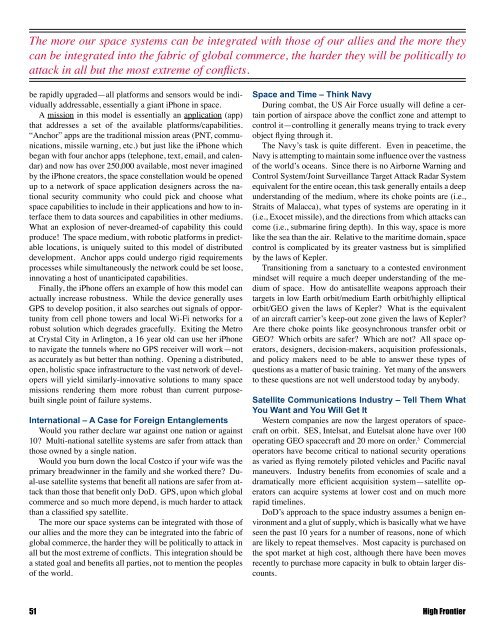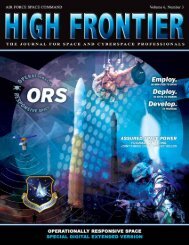Schriever Wargame 2010 - Air Force Space Command
Schriever Wargame 2010 - Air Force Space Command
Schriever Wargame 2010 - Air Force Space Command
- No tags were found...
You also want an ePaper? Increase the reach of your titles
YUMPU automatically turns print PDFs into web optimized ePapers that Google loves.
The more our space systems can be integrated with those of our allies and the more they<br />
can be integrated into the fabric of global commerce, the harder they will be politically to<br />
attack in all but the most extreme of conflicts.<br />
be rapidly upgraded—all platforms and sensors would be individually<br />
addressable, essentially a giant iPhone in space.<br />
A mission in this model is essentially an application (app)<br />
that addresses a set of the available platforms/capabilities.<br />
“Anchor” apps are the traditional mission areas (PNT, communications,<br />
missile warning, etc.) but just like the iPhone which<br />
began with four anchor apps (telephone, text, email, and calendar)<br />
and now has over 250,000 available, most never imagined<br />
by the iPhone creators, the space constellation would be opened<br />
up to a network of space application designers across the national<br />
security community who could pick and choose what<br />
space capabilities to include in their applications and how to interface<br />
them to data sources and capabilities in other mediums.<br />
What an explosion of never-dreamed-of capability this could<br />
produce! The space medium, with robotic platforms in predictable<br />
locations, is uniquely suited to this model of distributed<br />
development. Anchor apps could undergo rigid requirements<br />
processes while simultaneously the network could be set loose,<br />
innovating a host of unanticipated capabilities.<br />
Finally, the iPhone offers an example of how this model can<br />
actually increase robustness. While the device generally uses<br />
GPS to develop position, it also searches out signals of opportunity<br />
from cell phone towers and local Wi-Fi networks for a<br />
robust solution which degrades gracefully. Exiting the Metro<br />
at Crystal City in Arlington, a 16 year old can use her iPhone<br />
to navigate the tunnels where no GPS receiver will work—not<br />
as accurately as but better than nothing. Opening a distributed,<br />
open, holistic space infrastructure to the vast network of developers<br />
will yield similarly-innovative solutions to many space<br />
missions rendering them more robust than current purposebuilt<br />
single point of failure systems.<br />
International – A Case for Foreign Entanglements<br />
Would you rather declare war against one nation or against<br />
10 Multi-national satellite systems are safer from attack than<br />
those owned by a single nation.<br />
Would you burn down the local Costco if your wife was the<br />
primary breadwinner in the family and she worked there Dual-use<br />
satellite systems that benefit all nations are safer from attack<br />
than those that benefit only DoD. GPS, upon which global<br />
commerce and so much more depend, is much harder to attack<br />
than a classified spy satellite.<br />
The more our space systems can be integrated with those of<br />
our allies and the more they can be integrated into the fabric of<br />
global commerce, the harder they will be politically to attack in<br />
all but the most extreme of conflicts. This integration should be<br />
a stated goal and benefits all parties, not to mention the peoples<br />
of the world.<br />
<strong>Space</strong> and Time – Think Navy<br />
During combat, the US <strong>Air</strong> <strong>Force</strong> usually will define a certain<br />
portion of airspace above the conflict zone and attempt to<br />
control it—controlling it generally means trying to track every<br />
object flying through it.<br />
The Navy’s task is quite different. Even in peacetime, the<br />
Navy is attempting to maintain some influence over the vastness<br />
of the world’s oceans. Since there is no <strong>Air</strong>borne Warning and<br />
Control System/Joint Surveillance Target Attack Radar System<br />
equivalent for the entire ocean, this task generally entails a deep<br />
understanding of the medium, where its choke points are (i.e.,<br />
Straits of Malacca), what types of systems are operating in it<br />
(i.e., Exocet missile), and the directions from which attacks can<br />
come (i.e., submarine firing depth). In this way, space is more<br />
like the sea than the air. Relative to the maritime domain, space<br />
control is complicated by its greater vastness but is simplified<br />
by the laws of Kepler.<br />
Transitioning from a sanctuary to a contested environment<br />
mindset will require a much deeper understanding of the medium<br />
of space. How do antisatellite weapons approach their<br />
targets in low Earth orbit/medium Earth orbit/highly elliptical<br />
orbit/GEO given the laws of Kepler What is the equivalent<br />
of an aircraft carrier’s keep-out zone given the laws of Kepler<br />
Are there choke points like geosynchronous transfer orbit or<br />
GEO Which orbits are safer Which are not All space operators,<br />
designers, decision-makers, acquisition professionals,<br />
and policy makers need to be able to answer these types of<br />
questions as a matter of basic training. Yet many of the answers<br />
to these questions are not well understood today by anybody.<br />
Satellite Communications Industry – Tell Them What<br />
You Want and You Will Get It<br />
Western companies are now the largest operators of spacecraft<br />
on orbit. SES, Intelsat, and Eutelsat alone have over 100<br />
operating GEO spacecraft and 20 more on order. 3 Commercial<br />
operators have become critical to national security operations<br />
as varied as flying remotely piloted vehicles and Pacific naval<br />
maneuvers. Industry benefits from economies of scale and a<br />
dramatically more efficient acquisition system—satellite operators<br />
can acquire systems at lower cost and on much more<br />
rapid timelines.<br />
DoD’s approach to the space industry assumes a benign environment<br />
and a glut of supply, which is basically what we have<br />
seen the past 10 years for a number of reasons, none of which<br />
are likely to repeat themselves. Most capacity is purchased on<br />
the spot market at high cost, although there have been moves<br />
recently to purchase more capacity in bulk to obtain larger discounts.<br />
51 High Frontier











